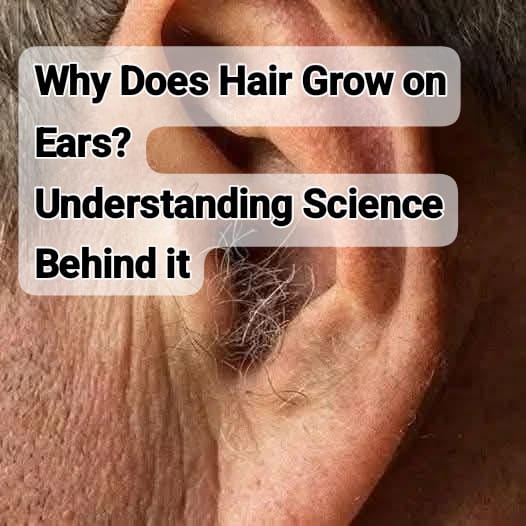Why Does Hair Grow on Ears? Understanding the Science Behind It
Have you ever noticed hair sprouting from your ears or seen it on someone else and wondered why that happens? While it might seem unusual, the growth of ear hair is actually quite common, especially among aging men. It might appear sudden or even excessive, but rest assured—it’s usually a completely normal part of the body’s aging and hormonal process.
In this detailed article, we’ll explore the reasons why hair grows on ears, what it signifies about your body, and how to manage it if it becomes a cosmetic concern.
What Is Ear Hair?
Before we dive into the causes, let’s clarify what ear hair is. There are two types of hair you may find in and around your ears:
- Vellus Hair: This is the fine, thin, nearly invisible hair that covers most parts of your body, including the ears.
- Terminal Hair: This is the thicker, darker, and longer hair that often appears in places like the scalp, face, armpits, and, yes, sometimes the ears.
As people age, vellus hair in certain areas may turn into terminal hair, which is when ear hair becomes more noticeable and prominent.
The Role of Hormones
The primary reason for the growth of thick hair on the ears is hormonal changes—specifically, androgens, which are male hormones such as testosterone and dihydrotestosterone (DHT).
1. Testosterone and DHT
- Testosterone is the main male sex hormone responsible for the development of secondary sexual characteristics like facial hair, deep voice, and muscle mass.
- DHT is a derivative of testosterone and is even more potent in affecting hair follicles.
As men age, testosterone levels may decrease overall, but the body’s sensitivity to DHT can increase. DHT acts on certain hair follicles in the ears, nose, and eyebrows, triggering the transformation of vellus hair into terminal hair.
That’s why older men often experience hair thinning on the scalp (due to DHT sensitivity there) and an increase in ear, nose, and eyebrow hair growth.
Why Do Some People Get It More Than Others?
Not everyone experiences prominent ear hair growth, and the degree can vary from person to person. The reasons include:
- Genetics: If your father or grandfather had noticeable ear hair, there’s a good chance you might as well.
- Hormonal Sensitivity: Some people have hair follicles that are more sensitive to DHT than others.
- Age: The older you get, the more likely these changes are to happen, particularly after the age of 40 or 50.
- Gender: Men are far more likely to develop noticeable ear hair due to higher androgen levels.
Cultural Beliefs and Misconceptions
In some cultures, ear hair is believed to be a sign of wisdom, virility, or longevity. In others, it may be viewed as unsightly or a symbol of aging. There’s even a common myth that shaving or trimming ear hair causes it to grow back thicker. In reality, that’s not true—the hair might feel coarser because it’s cut at an angle, but the follicle remains unchanged.
Medical Perspectives
While ear hair is usually harmless, sudden or excessive hair growth can sometimes indicate underlying medical issues, particularly if accompanied by other symptoms. These include:
- Endocrine Disorders: Conditions like Cushing’s syndrome or adrenal gland disorders can alter hormone levels and affect hair growth.
- Hirsutism: Though rare in men, hirsutism is a condition more commonly seen in women that leads to excessive body hair due to hormonal imbalance.
- Certain Medications: Some medications can stimulate hair growth as a side effect.
If you notice a rapid or unusual change in body hair, it’s a good idea to consult a healthcare provider.
The Difference Between Ear Hair and Hair in the Ear Canal
It’s important to distinguish between hair on the outer ear (auricle) and inside the ear canal.
- Outer Ear Hair: This is the visible hair that appears on the helix or the lobes. It’s primarily a cosmetic issue.
- Inner Ear Hair: Some hair inside the ear canal serves a protective function. It helps keep out dust, debris, and insects.
Removing too much hair from inside the ear canal can sometimes interfere with this protective barrier, so it should be done cautiously.
How to Manage or Remove Ear Hair
For those who prefer a clean and groomed look, there are several safe and effective methods to manage ear hair:
1. Trimming
- Use specialized ear and nose hair trimmers.
- Quick and painless.
- Regular maintenance required.
2. Waxing
- Longer-lasting results than trimming.
- Can be slightly painful and should be done professionally to avoid injury.
3. Tweezing
- Best for a few stray hairs.
- Can be painful and time-consuming.
4. Laser Hair Removal
- A more permanent solution.
- Targets hair follicles to reduce growth over time.
- Usually requires multiple sessions and can be expensive.
5. Depilatory Creams
- Not commonly recommended for ears due to sensitivity.
- May cause burns or irritation.
Should You Be Concerned?
In most cases, ear hair is a normal part of aging and doesn’t indicate any health problems. However, if you notice any of the following, it’s worth checking with a doctor:
- Sudden or excessive growth.
- Accompanying symptoms like fatigue, weight changes, or skin changes.
- Hair growth in women in typically male-pattern areas (face, chest, ears).
Fun Fact: The World’s Longest Ear Hair!
In 2007, an Indian man named Radhakant Bajpai made it into the Guinness World Records for having the longest ear hair, measuring over 25 centimeters (9.8 inches). He reportedly considered it a sign of good luck and wisdom!
Hair growth on the ears might catch you by surprise, especially as you age, but it’s almost always a normal phenomenon tied to hormonal changes—particularly DHT levels in the body. While it might seem like an odd place for hair to appear, there’s no need to worry unless you experience rapid or excessive growth.
Whether you choose to embrace it, trim it, or get rid of it altogether, know that ear hair is simply part of the unique journey of the human body through time.
Frequently Asked Questions (FAQs)
1. Is ear hair a sign of high testosterone?
Not necessarily. It’s more about how your hair follicles respond to DHT, a derivative of testosterone, rather than how much testosterone you have.
2. Can women get ear hair too?
Yes, but it’s less common and usually less noticeable. If it becomes excessive, it may be a sign of a hormonal imbalance.
3. Is it bad to remove ear hair?
Not at all, as long as you do it safely. Avoid inserting sharp objects into the ear canal and consider professional grooming methods if needed.
4. Can ear hair be prevented?
You can’t really prevent it if it’s genetic or hormonal, but you can manage its appearance through regular grooming or medical treatments like laser removal.






Leave feedback about this